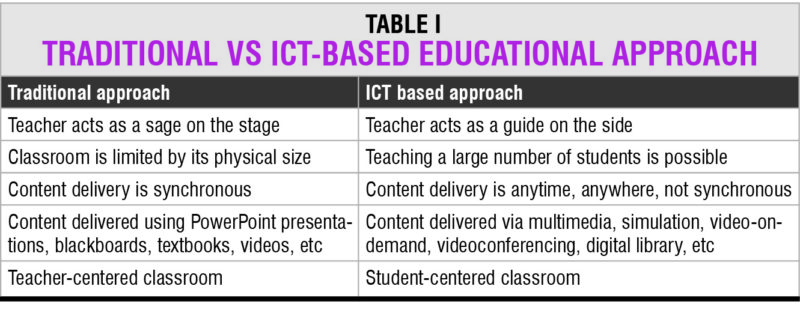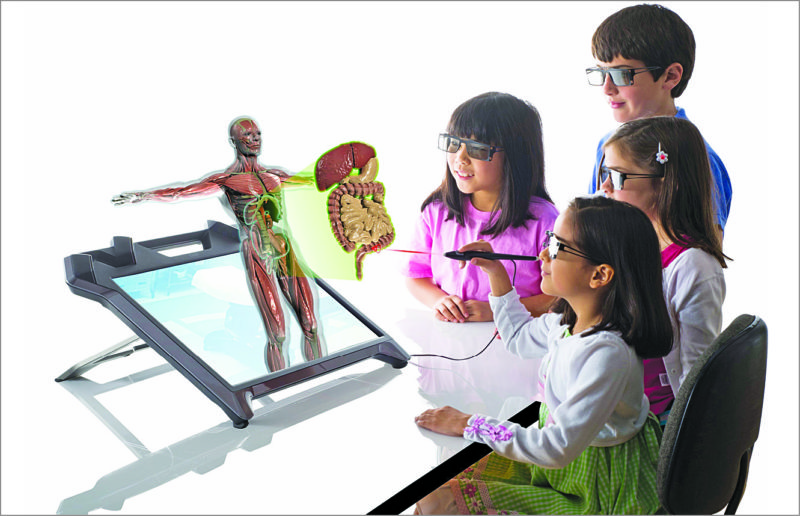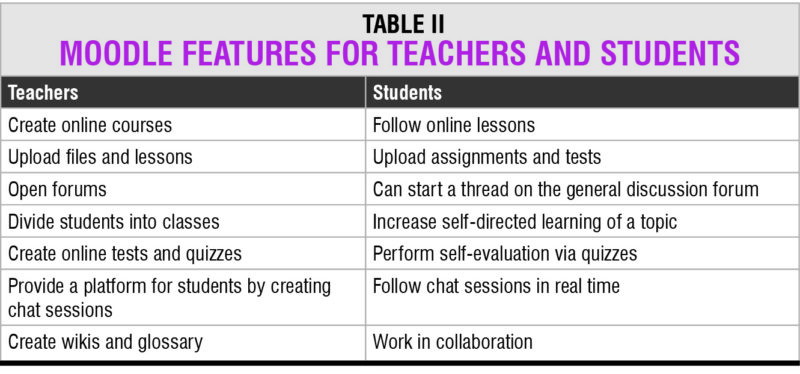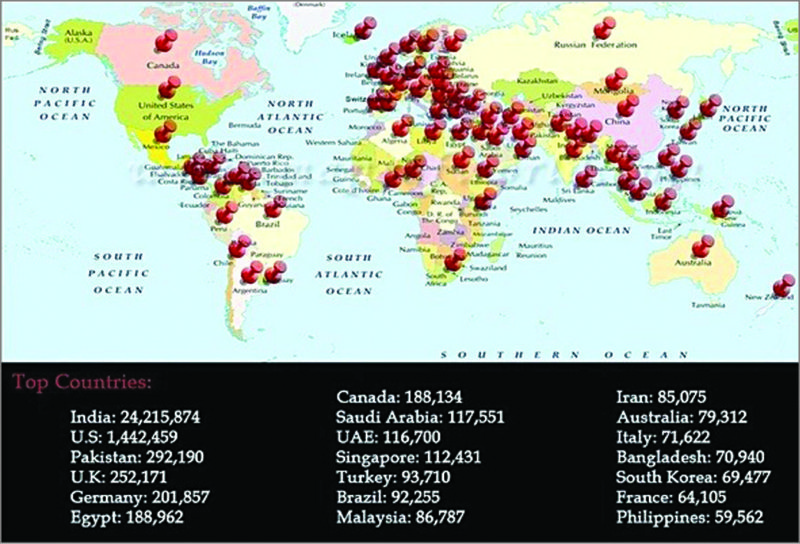Information and communication technologies (ICTs) have brought about a paradigm shift in education. Online educational methodology and tools like massive open online course (Mooc), modular object-oriented dynamic learning environment (Moodle), videoconferencing, virtual laboratories, screencasts, e-mail, forums, search engines, blogs, podcasts, vodcasts, wikis, vokis, high-tech 3D graphics, e-Groups, learning dialogue videos, learning-by-doing videos, digital game/toy-based learning and flipped-classrooms with associated pedagogy of active learning have quickly emerged as the backbone of effective education in this century. In fact, blended learning is the necessity of 21st century.
Benefits
ICTs provide a great solution for information collection and sharing, making learning more relaxed and productive—that too for all, anytime and anywhere. Tools like free and open source software (FOSS), and websites like github.com and SourceForge.net, help students with knowledge building, reflection, sharing and collaboration in project work.
ICTs also promote self-evaluation and self-study via online tools. Users can learn in their own dialects, which fills the gap of language barrier in teaching-learning process.

Integration of ICTs in education helps students, teachers and administrators alike. ICTs help where traditional methods of learning may not be effective, such as for students with learning disabilities like dyscalculia and dyslexia.
Research and revision can be done on the Internet as well as by using storage media like CD-ROMs and USB drives and application programs. Application programs with animation, video, quizzes and sound make learning more interactive.
Teachers and administrators use ICT tools like electronic data interchange or management information system for quick and accurate exam entries or other data logging operations. This reduces expenditure (printing and posting) and errors as well.
As there is less paper work, it’s more environment-friendly and saves teachers’ time.
Attendance monitoring software can automatically send a message to parents if their child is absent from class. Some schools are now using ICT to manage their day-to-day activities and monitor students. Innovative teaching-learning practices and methodologies are emerging with integration of ICT in learning.
Tools and methodologies employed
Digital games and toys
Digital games and toys shape thinking and creativity ability of learners. Animated cartoon learning videos, storytelling toys, and educational learning tablets and computer-like gadgets have emerged as guided and effective learning tools for kids.
Well-designed collaborative 3D learning games are emerging as a future learning tool for smart classrooms. These scaffold a student’s interactions with peers and teachers in real time.
IIT Bombay has introduced a low-cost laptop, FOSSEE, with more than 150 open source software packages on this system.
The Indian government is also spending a lot of money to create good-quality educational content through initiatives such as National Programme on Technology Enhanced Learning (NPTEL) and Virtual Labs. Another important initiative is Spoken Tutorial for IT training.

Simulation software
Simulation tools are used when conducting experiments on a real system would be impossible or impractical; for example, when prototyping and testing a system involves a high cost, a delicate product doesn’t support extensive tests, or duration of the experiment in real time is impractical.
Simulation tools help to disseminate conceptual and complex ideas to a wide variety of learners using appropriate media and methods to promote understanding.
Going beyond demos, simulation provides animated, interactive and game-like environments to enhance analytic skill. Computer simulation increases perception of students.

Virtual reality and augmented reality
Augmented reality and virtual reality are both related technologies, and using 3D environment or head-mounted display these provide an enhanced or enriched experience of an imaginary reality.
Virtual reality is commonly achieved through a head-mounted display, or handheld controller. It is an artificial simulation of a real-life environment or situation where people can have hands-on practice, like flight simulation for aircraft pilots. It immerses the users by making them feel like they are experiencing the situation.
On the other hand, augmented reality is used more in mobile devices like smart phones, laptops and tablets. Augmented reality-based piano learning apps/trainers are also available in the market. Virtual Reality Modeling Language (VRML) is the coding language used for virtual reality.
Skills can be easily enhanced through virtual and augmented reality-based training. For example, new train drivers can be trained in driving skills using simulators that provide a realistic simulation of any event and allow exercise of control in any crisis situation.
Such a training provides the opportunity to safely train the driver in avoiding real-life accidents.
The future of education resides in virtual reality and augmented reality environments where students from around the world converge in a magical hands-on learning experience.
Virtual reality creates an immersive audio, visual and spatial learning environment, which helps students to explore and learn at their own pace.
Amplitude-modulated signal generation using NI-FGEN waveform generator—a virtual instrument (Image courtesy: www.ni.com)[/caption]
Flipped classrooms
Flipping the classroom is a new approach to education. It reverses the traditional roles of classroom lecture and assignment at home. In the traditional model, the teacher delivers lectures to the students in a classroom.
Then the students do their assignments at home, maybe with the help of a parent or Internet. In the flipped classroom model, students are directed to watch short-duration screencasts or video lectures at home before joining the class. Then students do exercises in class in peer or collaborative groups.
Flipped classrooms help to enhance student interactions in the classroom. Flipped classrooms with associated pedagogy of active learning like well-designed think-pair-share, peer instruction, team-pair-solo and paired-problem-solving activity help to enhance problem solving, decision making and conceptualisation skill of learners.
An effective flipped classroom strategy is one in which information transmission happens outside the classroom and information assimilation happens inside the classroom.

Moocs and Moodle
Moodle is an open source web application used to create interactive online learning sites. This free online learning management system enables educators to create their own private website filled with dynamic courses that extend learning anytime, anywhere.
Its peer grading feature allows learners to grade and assess their own and other course members’ work as a group. Moocs provide free access to organised content with personalised learning environments using blogs, wikis, google groups, Moodle, etc. A large number of free courses are available as Moocs from organisations such as edX.
Discussion forums help with information acquisition, collaboration, concept clarification, review or feedback.
Technology-enhanced learning environment, self-learning, skill improvement and lifelong learning are the key aspects of Moocs and Moodles.

In India NPTEL is a Mooc provider, promoted and funded by the Ministry of Human Resource Development (MHRD), with seven IITs and IISc as its partner institutes.
It currently has 160 ongoing courses with about 350 completed courses and a total of 1.5 million students certified as of July 2017. To promote ICT inclusion, MHRD has also started a national award for teachers using ICT for innovation in education.

Way forward
ICT will become a strong catalyst for a sea change among many educational practices. There is a need to shift from teacher-centered classrooms to student-centric classrooms for outcome-based education. Using technology, teachers can create student-friendly environments for in-class as well out-of-class learning.
The time is ripe to rethink and redesign the educational systems, processes and ICT-based learning pedagogies. Researchers are working on an amalgamation of cognitive capabilities and the Internet of Things technologies to develop personalized learning tools for both students and educators.
With a radical backhaul of the education system in sight, there is also an urgent need to train teachers in the use of ICT tools.




